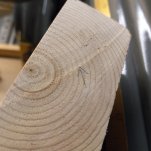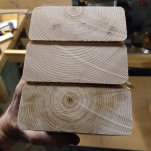How to install the app on iOS
Follow along with the video below to see how to install our site as a web app on your home screen.
Note: This feature may not be available in some browsers.
You are using an out of date browser. It may not display this or other websites correctly.
You should upgrade or use an alternative browser.
You should upgrade or use an alternative browser.
Replacing hardened steel slide rods on Wadkin Radial Arm Saw
- Thread starter tooltalk
- Start date
- Replies 27
- Views 1,356
rons
Diamond
- Joined
- Mar 5, 2009
- Location
- California, USA
I was holding back on that. What kind of accuracy are you looking for on a radial arm?In my earlier days I have built and crafted some very fine things with just a radial arm saw. Because it was all I had. As I progressed the radial saw was used to chunk stock to smaller lengths for processing on other machines. Rough mill type stuff.
Where I worked a guy was getting into wood working and had the plan to get a radial arm.
I had a table saw and couldn't talk him out of the radial arm. My thought was they are mostly used for rough construction.
It looks like the bars can be rotated 180 CW. Or side swapped. A swap might ignore the bad spots.
If the mounting holes are not symmetric then forget about this idea.
I honestly think that may be a discussion for another thread and I understand radial arm saws aren't for everyone.I was holding back on that. What kind of accuracy are you looking for on a radial arm?
Where I worked a guy was getting into wood working and had the plan to get a radial arm.
I had a table saw and couldn't talk him out of the radial arm. My thought was they are mostly used for rough construction.
I have another Rockwell 14" RAS and it is pretty accurate. I think the Wadkin should be in the same league, but when I made my first test cuts with it I noticed the bumps I was feeling in the carriage where being transferred to the cut end of the wood as a ridge. You can see in the pics below each piece of wood has a ridge in the same spot. That's where the carriage bumps on a rough spot on the rod around the first screw hole. I certainly think a saw of this quality should be capable of making a clean cut in a 2x4.


Last edited:
Bill D
Diamond
- Joined
- Apr 1, 2004
- Location
- Modesto, CA USA
I would think the rods are located in milled pockets. This would mean the screws are roughly located and just hold the rods down into the holders.
Bill D
Bill D
rons
Diamond
- Joined
- Mar 5, 2009
- Location
- California, USA
Clean work.
If you are fond of the original rods and they don't have to be exactly 0.500:
If you had a collet lathe. Position the rod half way over lathe bed. Skim a few thousands. Reverse the rod and repeat.
Mount something like a dremel tool or better at the tool post.
Another way is to just position half way and use sand paper with a backing edge. Measure often.
Or buy enough 1/2" bar, drill holes, and heat it with two torches and quench in oil.
If you are fond of the original rods and they don't have to be exactly 0.500:
If you had a collet lathe. Position the rod half way over lathe bed. Skim a few thousands. Reverse the rod and repeat.
Mount something like a dremel tool or better at the tool post.
Another way is to just position half way and use sand paper with a backing edge. Measure often.
Or buy enough 1/2" bar, drill holes, and heat it with two torches and quench in oil.
Last edited:
So I took the rods to my machinist friend. When I first went in to see him we sat in his office and talked about a few options, then he said he might be able to stone and polish them to remove the rough spots. He got a sharpening stone and rubbed them a bit and said they were much harder than he expected, but he was pretty sure they could clean them up. I think he said they would put them on a lathe, but I'm not too sure.
He sent me a text yesterday and said he "had ond of his guys finish polishing the rods", but he was pretty busy when I picked them up. So I didn't get to talk to him about what they did, but the rods definitely looked much better. I installed them tonight and I didn't feel the bumping like I did before and the cut quality in a few test cuts looked much better too. No ridges in the cut ends like before.
I'll have to do some more cuts to be sure, but I'm hoping it was a successful repair.
He sent me a text yesterday and said he "had ond of his guys finish polishing the rods", but he was pretty busy when I picked them up. So I didn't get to talk to him about what they did, but the rods definitely looked much better. I installed them tonight and I didn't feel the bumping like I did before and the cut quality in a few test cuts looked much better too. No ridges in the cut ends like before.
I'll have to do some more cuts to be sure, but I'm hoping it was a successful repair.
mjk
Titanium
- Joined
- Oct 20, 2005
- Location
- Wilmington DE USA
Just for future reference Thompson did used to offer modifications to their rods when ordered new from a rep
Think of their linear rails that are tapped
Think of their linear rails that are tapped
stephen thomas
Diamond
- Joined
- Jun 3, 2001
Glad to hear it worked so well!
(so far as you noted, anyway)
You owe him.
"His guy" probably had more than a couple hours in it.
FWIW, putting the work in a lathe, it is possible to make quite accurately round rods, uniformly on diameter though not necessarily with any straightness tolerance (which is not really necessary for this app) with a shop rigged "crackerjack" lap, possibly with CI jaws. For dimensional accuracy, a method to gradually but positively adjust the diameter is useful. (adjustable screw stop, e.g.)
smt
(so far as you noted, anyway)
..... said they were much harder than he expected, but he was pretty sure they could clean them up. I think he said they would put them on a lathe, but I'm not too sure.
He sent me a text yesterday and said he "had ond of his guys finish polishing the rods",....
You owe him.

"His guy" probably had more than a couple hours in it.
FWIW, putting the work in a lathe, it is possible to make quite accurately round rods, uniformly on diameter though not necessarily with any straightness tolerance (which is not really necessary for this app) with a shop rigged "crackerjack" lap, possibly with CI jaws. For dimensional accuracy, a method to gradually but positively adjust the diameter is useful. (adjustable screw stop, e.g.)
smt
Similar threads
- Replies
- 15
- Views
- 695

